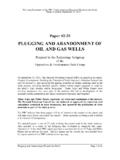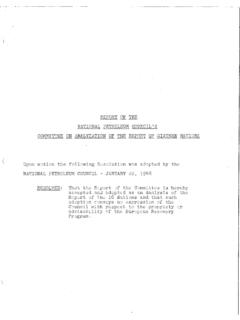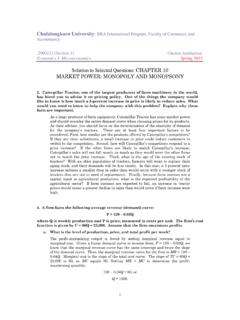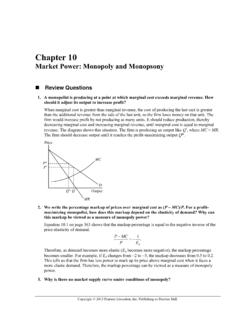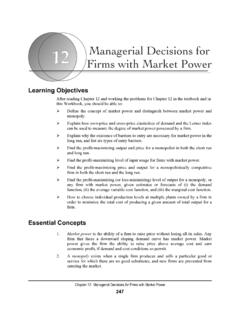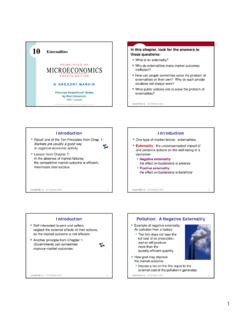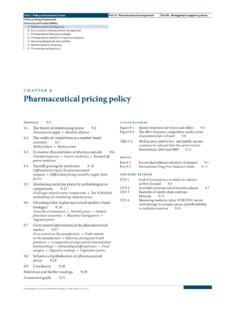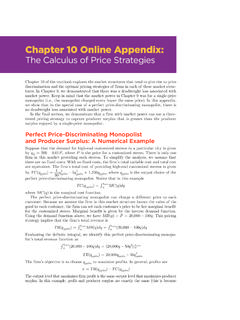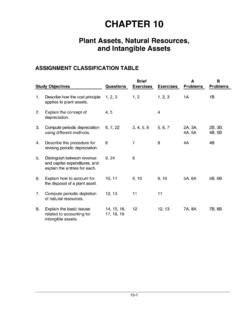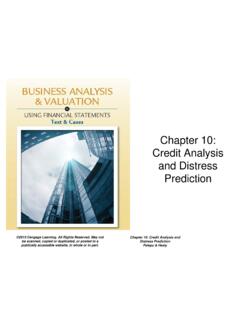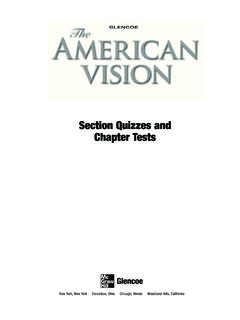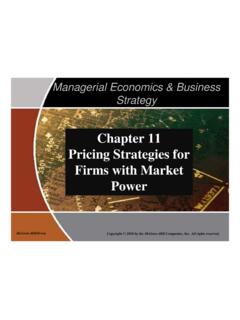Transcription of INTRODUCTION Overview - NPC
1 chapter 10 HEAVY-DUTY ENGINES & VEHICLES 10-1As such, fuel economy tends to be a much larger concern for trucks than for passenger cars. In this sense, trucks are designed for application- specific uses to conduct a job as efficiently as pos-sible, with the lowest total cost of ownership. A single car is typically purchased for multiple needs, including commuting, hauling small loads, driving periodically on long trips, maneuvering through city streets, etc. Passenger cars are typically purchased based upon their interior passenger and cargo vol-ume. By contrast, trucks tend to be selected for a specific duty cycle, which tends to dominate their day-to-day activity. Truck applications are diverse, ranging from the well-known 18-wheeler Class 8 line-haul truck, to dump trucks, delivery trucks, construction vehicles, buses, and a long list of niche applications.
2 The majority of trucks are powered by diesel engines, which are both more efficient and longer lasting than gasoline duty cycle diversity across different applica-tions requires that fuel efficiency be measured in a way that considers both the miles traveled per gal-lon and the work being done while traveling. One typical unit of measurement that considers this complexity is ton-miles per gallon. This is an impor-tant distinction when evaluating technologies for work trucks, especially line-haul trucks, and when comparing across vehicle types. For example, the 6 miles per gallon (mpg) fuel economy of a line-haul truck seems paltry compared to 40 mpg pas-senger vehicles. However, when the fuel consumed to move payload is considered, a new perspective emerges. Consider a large tractor-trailer carrying a 42,000-pound payload and achieving 6 mpg of fuel economy.
3 This 6 mpg translates to 126 ton-miles per gallon. That is, a fleet of such vehicles could carry 126 tons of freight for one mile, using a single gallon of fuel. By contrast, a typical passenger car INTRODUCTIONO verview Although there are far fewer heavy-duty (HD) trucks than cars on the road, HD trucks are a significant factor in overall transportation-energy consumption. HD trucks, defined as on-road vehicles in Class 3 through 8, consume over 20% of the fuel used in transportation in the United That share is expected to grow to almost 30% by 2050, based on extrapolations of the Energy Information Administration s (EIA) Annual Energy Outlook 2010 (AEO2010). This chapter studies the energy consumption of HD trucks, and reviews a wide variety of technologies to increase fuel economy with a specific focus on liquid fuels.
4 As such, it is a companion chapter to chapter Nine, Light-Duty Engines & Vehicles, as well as chapter Fourteen, Natural Gas. There are many differences between light-duty (LD) vehicles (passenger cars) and HD vehicles, which requires that they be considered separately. An important difference between passenger cars and HD vehicles is the purchase decision. Passen-ger cars are purchased under many of the same considerations as consumer goods, whereas HD vehicles often are purchased as capital goods for the purpose of helping a company or government entity conduct business and/or perform a spe-cific, dedicated task. Because trucks are used in the context of a business operation, cost tradeoffs are considered explicitly in a purchase decision.
5 Fuel costs are typically the second highest operat-ing cost for a trucking company, which provides competitive incentive to increase fuel economy. 1 AEO2010 Base ADVANCING TECHNoLoGY foR AmERICA S TRANSPoRTATIoN fUTUREF ramework This chapter examines technologies that can lead to improved GHG emissions, energy security, and economics related to on-highway HD vehicles. The chapter focuses on three areas, as shown in Figure 10-1. yEngine technologies technologies that improve the fuel economy of the vehicle s engine yVehicle technologies technologies that either reduce frictional energy losses, such as aerody-namic improvements, or emissions of the vehicle yVehicle operations technologies that either reduce the demand to drive or improve the pro-ductivity of technologies can have very different impacts across the application space.
6 In order to appropriately address these differences, this chap-ter evaluates the technology impact separately across the following applications. yClass 8 line-haul trucks yClass 7&8 vocational trucks yBuses yClass 3-6 medium-duty (MD) 10-2 illustrates the sources of energy loss for a Class 8 truck and the effect of duty cycle on the balance of energy losses across the various catego-ries of indicated by Figure 10-2, the greatest oppor-tunities to improve the energy efficiency of com-mercial vehicles will come from enhancements to the engine and exhaust system, rolling resistance of the tires, and aerodynamics of the vehicle. Technol-ogies such as combustion optimization, idling tech-nology, hybrids, advanced gasoline engines, waste heat recovery, and exhaust after-treatment will all be discussed as means to improve the fuel economy and GHG emissions of engines used in commer-cial vehicles.
7 Although wide-base single tires and proper tire maintenance do not improve the energy efficiency of the vehicle as greatly as the engine technologies, they are less expensive than many engine-based technologies and more conducive to being retrofitted to the vehicle. Also, a selection of aerodynamically enhanced body fittings and the expected gains in fuel economy will be discussed may carry 500 pounds of payload, in the form of passengers, luggage, etc. If such a passenger car obtains 40 mpg while carrying 500 pounds of pay-load, it has achieved only 10 ton-miles per gallon, or less than 10% of the fuel economy of the HD truck. Because cars and trucks are built for different jobs, different fuel economy metrics are appropri-ate. Mpg is a common and accepted metric for the passenger car, and work-based ton-miles per gal-lon is the right metric for HD trucks.
8 When trans-lated to greenhouse gas (GHG) regulation, the work-based metric becomes grams of CO2 per ton-mile. Although the ton-mile per gallon metric is not explicitly used in the AEO2010 report, it is used in this discussion and analysis. ScopeThe focus of the Heavy-Duty Engines & Vehicles Subgroup was to analyze HD vehicles using liquid fuels and summarize studies assessing the fuel economy benefits and costs for a range of future engine and vehicle technologies. Included were: a range of spark ignition and compression ignition engine technologies; alternative combustion tech-nologies; improved transmissions; vehicle enablers such as low rolling resistance tires, improved aerodynamics, and mass reduction; and a range of hybridization options. Also included was an inves-tigation of how alternative fuels, or changes in fuel properties, can improve vehicle efficiency and how alternative fuels impact driving range and refuel-ing time.
9 This chapter focuses exclusively on HD trucks and buses defined as Classes 3 through 8 and specifically on liquid fuels. Class 2b vehi-cles are addressed in chapter Nine, Light-Duty Engines & Vehicles. The impact of improved truck fleet operations and driver behavior is also con-sidered, including technologies to improve overall system efficiency and reduce congestion. Finally, this chapter establishes a common vehicle base-line for evaluating vehicle technologies included in this study to ensure equitable treatment and evaluation of all the vehicle and propulsion system that are out of scope because they are covered elsewhere in the study include engines operating on gaseous fuels (including liquefied natural gas), plug-in electric vehicles, fuel cells, and free-piston 10 HEAVY-DUTY ENGINES & VEHICLES 10-3 Figure 10-1.
10 Vehicles by Class/Segment LARGE CARSMALL CARVEHICLESPICKUPSMALL SUVLARGE SUVLIGHT DUTYHEAVY DUTY MEDIUM DUTY BUSESCLASS 3-6 LONG-HAULTRUCKSCLASS 7&8 VOCATIONALENGINETECHNOLOGYVEHICLE TECHNOLOGYVEHICLE OPERATIONSN/AN/AN/AN/AN/AN/AN/AN/AN/AN/A N/AN/AN/AN/AN/APRIORITY AREA FOR TECHNOLOGYFOCUS AREA OF DISCUSSIONF igure 10-2. Energy Loss Range of Vehicle Attributes for a Class 8 Truckas Impacted by Duty Cycle, on a Level RoadENGINE LOSSESURBAN 58 60%INTERSTATE 58 59% AERODYNAMIC LOSSESURBAN 4 10%INTERSTATE 15 22% DRIVETRAINURBAN 5 6%INTERSTATE 2 4% INERTIA/BRAKINGURBAN 15 20%INTERSTATE 0 2% AUXILIARY LOADSURBAN 7 8%INTERSTATE 1 4% ROLLING RESISTANCEURBAN 8 12%INTERSTATE 13 16% Source: National Research Council of the National Academies, Technologies and Approaches to Reducing the Fuel Consumption of Medium- and Heavy-Duty Vehicles, 2010.
